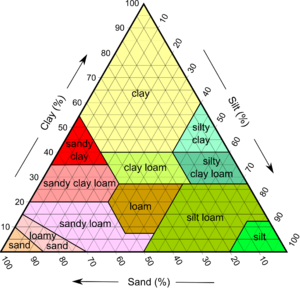Loam: Difference between revisions
No edit summary |
No edit summary |
||
| Line 1: | Line 1: | ||
Loam is a type of soil comprised of varying proportions of sand, silt, and clay. Loam was given the Latin name ''pinguis humus'' by the Roman poet Virgil. [2] | Loam is a type of <soil> comprised of varying proportions of sand, silt, and clay. Loam was given the Latin name ''pinguis humus'' by the Roman poet Virgil. [2] | ||
==Physical Properties== | ==Physical Properties== | ||
Revision as of 10:12, 7 May 2018
Loam is a type of <soil> comprised of varying proportions of sand, silt, and clay. Loam was given the Latin name pinguis humus by the Roman poet Virgil. [2]
Physical Properties
As seen in the figure to the right, the three types of soil can be combined in different amounts to form varying types of loam. The particle sizes range from large to small starting with sand, which is defined as having a particle size greater than 63 µm, silt, with a particle size greater than 2 µm but less than 63 µm, and clay, with particle sizes smaller than 2 µm. [1] Loamy soil is the soil type most likely to contain an ample amount of humus, or dead organic matter from plants and animals, that fosters plant growth.
Life within the soil
Some of the inhabitants of loamy soil include the water-dependent protozoa and Nematodes. They usually prefer soil with a greater proportion of silt than sand due to the former's superior water retention. [2] Acari, also known as mites, can tolerate more desiccation than other microorganisms, so they do not need as much exposure to water and can live in a larger range of soil types.
Fertility of loamy soil
Loam is the best-suited soil type for growing most plants due to its propensity for holding enough water and nutrients to satisfy their needs. [3] Clay dominant soils, although rich in nutrients, have poor drainage due to the small pore size and is not ideal for roots to grow in due to its hard packed texture, which roots often have difficulty penetrating. Sandy soils do not hold water well, and silt does not hold nutrients well. By offering a mixture of these particles, they accentuate the benefits and balance out the detriments of each particle size, forming fertile loam, the ideal soil type for many plant types. The ideal loamy soil patch is, by mass, 40-60% pore space containing air and water. [5]
Specifically, loamy soil is the preferred growing environment for plants such as strawberries, corn, sunflowers, beets, kale, lettuce, mint, sweet potatoes, peas, tomatoes, and turnips, among others. [4]
Field Classification
Due to its mixture of sand, silt, and clay, a loam soil will have unique characteristics to look for. For the Soil Texture Triangle figure above, if one can determine the soil's percent by weight of any of the two soil characteristics, the subtracting the two known values from 100% will yield the percentage of the unknown value. When using the figure, one typically starts by following the sand value, first, but because as long as at least two values are known, this is not mandatory. [6]
References
[1] Kaufmann, Robert K.; Cutler J. Cleveland (2008). Environmental Science. McGraw-Hill. pp. 318–319. ISBN 978-0-07-298429-3.
[2] Coleman, D. C., Crossley, D. A., Jr., & Hendrix, P. F. (2004). Fundamentals of Soil Ecology (2nd ed.). Amstherdan: Elsevier.
[3] R. B. Brown (September 2007). "Soil Texture" (PDF). Agronomy Fact Sheet Series: Fact Sheet SL-29. Cornell University, Department of Crop and Soil Sciences. Retrieved May 2, 2017.
[4] Old Farmer's Almanac. “Soil Type: Loamy.” Old Farmer's Almanac, www.almanac.com/plants/soil/loamy.
[5] Brady, N. C., and R. R. Weil. The Nature and Properties of Soils. 11th ed. Upper Saddle River, N.J.: Prentice Hall, 1996.
[6] "The Textural Triangle" The University of Idaho. 2016. Retrieved 2018-04-27. http://oneplan.org/Water/soil-triangle.asp.
